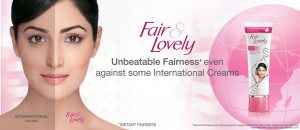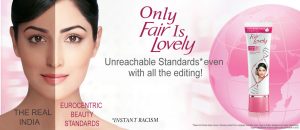
The image above shows an advertisement for a popular skin lightening cream in India. The advertisement depicts a woman with one side of the face lighter than the other, to show the results of the Fair & Lovely cream. However, behind the advertisement and the cream, there is a deep-rooted issue of racism and colourism. India has a long history of being a colonial subject, and as a result, has been affected by colonial standards of civilization and beauty. Despite the end of colonialism, the colonial era still has a reach today and there are still deeply embedded forms of discrimination in India that are a result of the history of colonialism. Along with colonially created standards, the caste system in India and traditional cultural values have created beauty standards in India that are set to Eurocentric ideals. Propelled by the current spread of mass media, fair skin has been deemed as beautiful, and darker skin has been labelled as undesirable (Paul 133, Hoskins). Media tactics like advertisements have constructed an image of an ‘ideal’ or ‘desirable’ woman which is often associated with blonde hair, blue eyes and fair skin – the epitome of a stereotypical Western woman.
Skin lightening creams have become increasingly popular in India (with Fair and Lovely being the #1 brand). India holds deep colourism beliefs, where fair skin is not only seen as more desirable, but it is valued more. Colourism refers to discrimination against darker skin tones, and it generally occurs among people of the same racial or ethnic grouping. This is evident for girls growing up in India. For example, they are made to believe they will not get married if they have darker skin, because it makes them undesirable. These girls will then resort to using skin lightening creams. These creams and brands are profiting off colourism and an ideal where the white women is the most desirable woman, and if you have dark skin you are not beautiful or valued. This is the problem that I have tried to address below through my jamming of the advertisement.

Through my jammed version of the advertisement, I tried to reveal issues with the advertisement and the product itself. Altering the brand name to Only Fair Is Lovely, I am directing the attention to the problem of the product. Skin lightening creams are a product of Eurocentric beauty standards that deem unfair skin to be ‘unlovely’. Along with this, I have edited the woman to show a darker woman on the left side to portray a realistic Indian woman, and instead of comparing what would be the ‘results’ of the cream, I have simply put in a subversive interpretation of the ad. The two sides, along with the caption The Real India, are an attempt to challenge discrimination against darker skin tones. I have also changed ‘instant fairness’ into instant racism, because by engaging with these products and brands, the consumers (and the companies themselves) are recreating these racist and discriminatory ideals of beauty.
In the slogan, I have also hinted at the effort of editing that went into the original advertisement. While some skin lightening creams contain bleaching agents, it is impossible to change the colour of your skin with a single cream. Most skin lightening advertisements use editing, like Photoshop. It also hints to the consumer that they are falling into not only a capitalist trap (since the standards are unreachable and they would be wasting their money), but taking part of a colourist discourse that is specifically directed at them to feel inferior. Companies are “capitalizing” on a racial hierarchy by “deepening…self-hate” to sell products (Hoskins). By making women feel like they need whiter skin to be beautiful, Fair & Lovely has been able to sell numerous products. This problem also goes beyond women – the brand has also created a secondary line aimed at men: Fair and Handsome.
By jamming the ad, I have tried to show the danger of advertisements and products like the Fair & Lovely skin lightening cream, which contribute to India’s struggle with colourism and discrimination, by targeting the consumers to rethink the racist discourse they are engaging in by buying these products.
REFERENCES:
Paul, Annie. “Beyond the Pale? Skinderella Stories and Colourism in India.” Ideaz. 14. (2016): 133-145, 150.
Hoskins, Tansy. “Skin-whitening Creams Reveal the Dark Side of the Beauty Industry.” The Gaurdian. 10 Feb. 2014. Web.